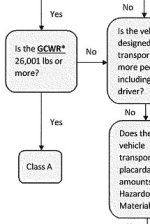I don't know how many different ways to say it, but 26k+ is class a.
You seem to miss the fact that IF the trailer GVWR is 10,000# or less the rules are different than if the trailer GVWR is over 10,000#
If you want to take one shitty flow chart as law, go ahead

Lets get back to the basics and read the class descriptions in their entirety and not skip the parts that punch holes in your argument?
Lets take a hypothetical 25,990 GVWR truck with 5 seats, towing a 9,990 GVWR trailer, no hazmat.
Here is what the FMCSA says for license class limits:
Drivers | FMCSA
https://www.fmcsa.dot.gov/registration/commercial-drivers-license/drivers said:
Class A*: Any combination of vehicles which has a gross combination weight rating or gross combination weight of 11,794 kilograms or more (26,001 pounds or more) whichever is greater, inclusive of a towed unit(s) with a gross vehicle weight rating or gross vehicle weight of more than 4,536 kilograms (10,000 pounds) whichever is greater.
- Truck GVWR is under 26,001
- Adding the trailer GVWR WOULD put us over 26k
- BUT since the trailer GVWR/GVW is under 10,000 it does NOT get included in the GCWR
As it says:
inclusive of a towed unit(s) with a gross vehicle weight rating or gross vehicle weight of more than 4,536 kilograms (10,000 pounds) whichever is greater.
So, Class A is NOT required as it doesn't fit the description of the class
https://www.fmcsa.dot.gov/registration/commercial-drivers-license/drivers said:
Class B*: Any single vehicle which has a gross vehicle weight rating or gross vehicle weight of 11,794 or more kilograms (26,001 pounds or more), or any such vehicle towing a vehicle with a gross vehicle weight rating or gross vehicle weight that does not exceed 4,536 kilograms (10,000 pounds).
Truck GVWR is under 26k, Trailer GVWR is under 10k
So, Class B is NOT required as it doesn't fit the description of the class
https://www.fmcsa.dot.gov/registration/commercial-drivers-license/drivers said:
Class C: Any single vehicle, or combination of vehicles, that does not meet the definition of Class A or Class B, but is either designed to transport 16 or more passengers, including the driver, or is transporting material that has been designated as hazardous under 49 U.S.C. 5103 and is required to be placarded under subpart F of 49 CFR Part 172 or is transporting any quantity of a material listed as a select agent or toxin in 42 CFR Part 73.
Does not meet Class A or B, under 16 passengers, no hazmat.
So, Class C is NOT required
That means that we have run out of CDL classes which leaves (drumroll)
Class D (regular driver, no CDL needed).
To reiterate the list, here is NY's list of classes (from:
https://www.dot.ny.gov/divisions/operating/osss/repository/cdl101.pdf )
For Class D they state:
- GVWR of 26,000 pounds or less
- May tow a vehicle with a GVWR of 10,000 pounds or less;
- or may tow a vehicle of more than 10,000 pounds providing the GCWR is not over 26,000 pounds
- RV GVWR 26,000 pounds or less
As such, with a Class D license you can tow a trailer of 10k GVWR or less behind a vehicle with a GVWR of 26k or less (ie: up to 36K GCWR
IF (and ONLY IF) the trailer is under 10k GVWR).
You can also tow a trailer of over 10k GVWR with a class D license as long as your GCWR remains under 26k
They also list a non-CDL Class C which I think is a holdover from when you couldn't get endorsements on a Class D license and is there for legacy reasons only.
Either way, the weight restrictions are the same as a Class D.
Aaron Z


